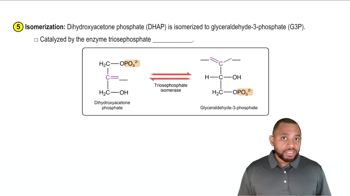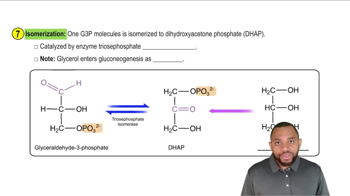Here are the essential concepts you must grasp in order to answer the question correctly.
Glycolysis
Glycolysis is a metabolic pathway that converts glucose into pyruvate, producing ATP and NADH in the process. It consists of ten enzyme-catalyzed reactions and is divided into two phases: the energy investment phase and the energy payoff phase. Understanding glycolysis is essential for grasping how glyceraldehyde 3-phosphate, a key intermediate, is further processed to generate energy.
Recommended video:
Glyceraldehyde 3-Phosphate (G3P)
Glyceraldehyde 3-phosphate (G3P) is a three-carbon sugar and an important intermediate in both glycolysis and the Calvin cycle. In glycolysis, G3P is converted into pyruvate through a series of enzymatic reactions, including oxidation and phosphorylation. Recognizing the role of G3P is crucial for understanding the transformations that lead to pyruvate production.
Recommended video:
Gluconeogenesis Concept 8
Enzymatic Reactions in Glycolysis
The conversion of glyceraldehyde 3-phosphate to pyruvate involves several key enzymatic reactions, including the actions of glyceraldehyde 3-phosphate dehydrogenase and pyruvate kinase. These enzymes facilitate the oxidation of G3P and the transfer of phosphate groups, ultimately leading to the formation of pyruvate. Familiarity with these enzymes and their functions is vital for comprehending the overall glycolytic pathway.
Recommended video:
 Verified step by step guidance
Verified step by step guidance Verified Solution
Verified Solution



 1:29m
1:29m